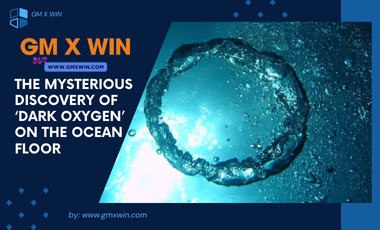The depths of the ocean are one of Earth’s final frontiers, teeming with mysteries and undiscovered phenomena. Among these enigmatic discoveries is the recent identification of what scientists are calling “dark oxygen” on the ocean floor. This mysterious substance has the potential to reshape our understanding of marine chemistry and biology. This article delves into the discovery, its implications, and the ongoing research aimed at unraveling the secrets of dark oxygen.
The Ocean Floor: An Unexplored Frontier
The Importance of the Ocean Floor
The ocean floor, covering over 70% of the Earth’s surface, is a critical component of our planet’s ecosystem. It plays a crucial role in regulating the Earth’s climate, supporting marine life, and acting as a vast reservoir of natural resources.
Challenges in Exploring the Ocean Floor
Exploring the ocean floor is fraught with challenges. The immense pressure, lack of light, and extreme temperatures make it a hostile environment for humans and equipment alike. Advanced technology, such as remotely operated vehicles (ROVs) and deep-sea submersibles, has been instrumental in recent discoveries.
The Discovery of Dark Oxygen
The Initial Discovery
The discovery of dark oxygen occurred during a deep-sea expedition aimed at studying hydrothermal vents. These vents, found along mid-ocean ridges, release mineral-rich water heated by the Earth’s mantle, creating unique ecosystems.
Unusual Observations
Researchers noticed unusual chemical signatures in water samples collected from the vicinity of hydrothermal vents. These samples exhibited oxygen levels that were significantly higher than expected, given the environment’s known chemical processes.
Identification of Dark Oxygen
Further analysis revealed that the excess oxygen was not in its typical molecular form (O2). Instead, it existed in a previously unknown state, now referred to as “dark oxygen.” This form of oxygen does not react chemically in the same way as molecular oxygen, making it a unique and mysterious discovery.
The Chemistry of Dark Oxygen
Understanding Oxygen States
Oxygen is a versatile element with several known states, including molecular oxygen (O2), ozone (O3), and various oxides. Dark oxygen represents a new and previously unidentified state.
Chemical Properties
Dark oxygen exhibits unique chemical properties. Unlike molecular oxygen, it does not readily form bonds with other elements. This inert nature raises questions about its formation, stability, and potential interactions with other substances.
Potential Sources
Researchers speculate that dark oxygen may originate from the intense heat and pressure near hydrothermal vents. These extreme conditions could facilitate the formation of dark oxygen from water molecules or other oxygen-containing compounds.
Implications for Marine Chemistry
Revisiting Ocean Chemistry Models
The discovery of dark oxygen necessitates a reevaluation of existing ocean chemistry models. Traditional models do not account for the presence of this mysterious form of oxygen, potentially altering our understanding of chemical processes in deep-sea environments.
Impact on Marine Life
Marine life, particularly organisms living near hydrothermal vents, may be affected by dark oxygen. These ecosystems rely on chemosynthesis, a process that uses chemical reactions to produce energy. The presence of dark oxygen could influence these reactions and the overall dynamics of these unique habitats.
Geochemical Cycles
Dark oxygen could play a role in geochemical cycles, particularly those involving oxygen and sulfur. Understanding its interactions with other elements could provide insights into the biogeochemical processes that shape the ocean floor.
Technological Advancements in Deep-Sea Exploration
ROVs and AUVs
Remotely operated vehicles (ROVs) and autonomous underwater vehicles (AUVs) have revolutionized deep-sea exploration. Equipped with advanced sensors and sampling equipment, these vehicles can navigate the harsh conditions of the ocean floor to collect data and samples.
Deep-Sea Submersibles
Manned deep-sea submersibles, such as Alvin and the Deepsea Challenger, have allowed scientists to explore the ocean floor firsthand. These submersibles can reach depths of several kilometers, providing valuable insights into deep-sea environments.
Analytical Techniques
Advances in analytical techniques, such as mass spectrometry and spectroscopy, have enabled the detection and analysis of dark oxygen. These techniques allow scientists to study the chemical properties of dark oxygen and its interactions with other substances.
Current Research and Future Directions
Ongoing Studies
Current research on dark oxygen is focused on understanding its chemical properties, formation mechanisms, and potential biological and geochemical impacts. These studies involve collaboration between chemists, biologists, and geologists.
Potential Applications
The discovery of dark oxygen could have practical applications. Understanding its formation and stability could lead to new methods for oxygen storage and transport, potentially benefiting industries such as energy and environmental science.
Expanding Exploration
Future deep-sea expeditions aim to expand the search for dark oxygen beyond hydrothermal vent regions. Exploring other deep-sea environments, such as abyssal plains and submarine canyons, could reveal additional sources and insights.
The Broader Implications of Dark Oxygen
Rethinking Earth’s Oxygen Cycle
The existence of dark oxygen challenges our current understanding of the Earth’s oxygen cycle. This discovery suggests that there may be unknown reservoirs and processes influencing the distribution and availability of oxygen on our planet.
Implications for Astrobiology
The discovery of dark oxygen also has implications for astrobiology, the study of life beyond Earth. Understanding the conditions that produce dark oxygen could inform the search for extraterrestrial life, particularly on ocean-bearing moons and planets.
Environmental and Climate Impact
The presence of dark oxygen in the deep sea could influence global biogeochemical cycles and, by extension, climate regulation. Further research is needed to understand its potential impact on these large-scale processes.
Conclusion
The discovery of dark oxygen on the ocean floor is a groundbreaking development in marine science. This mysterious form of oxygen challenges our existing knowledge of ocean chemistry and has far-reaching implications for various scientific fields. As researchers continue to unravel the secrets of dark oxygen, we can expect new insights into the fundamental processes that shape our planet and potentially others in the universe. The journey of discovery is just beginning, promising exciting advancements and a deeper understanding of the hidden depths of the ocean.




This is really interesting, You’re a very skilled blogger.
I’ve joined your rss feed and look forward to seeking more of your wonderful post.
Also, I’ve shared your web site in my social networks!